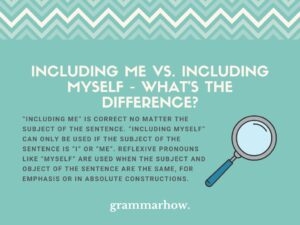When it comes to using the word “myself” in sentences, many people often get confused about when and how to use it correctly. Understanding the rules of proper usage can help you communicate more effectively and avoid common grammar mistakes.
Myself is a reflexive pronoun that is used when the subject of a sentence performs an action on itself. It is important to note that myself should only be used in specific contexts and not as a substitute for “me” or “I.”
Myself Usage Rules
1. Reflexive Pronoun: Myself should be used when the subject and object of a sentence are the same person or thing. For example, “I hurt myself while playing soccer.” In this sentence, “myself” refers back to the subject “I.”
2. Emphasis: Myself can also be used for emphasis, especially when the speaker wants to draw attention to themselves. For example, “I will do it myself” emphasizes that the speaker will personally take care of the task.
3. Avoid Overusing: It is important to avoid overusing myself in sentences where it is not necessary. Using myself unnecessarily can make your sentence sound awkward or incorrect. For example, “John and myself went to the store” should be corrected to “John and I went to the store.”
4. Position in a Sentence: Myself is usually placed after the subject pronoun and before the verb in a sentence. For example, “I myself am responsible for the mistake.”
5. Use with “I” or “Me”: Myself should not be used as a substitute for “I” or “me.” It is important to understand the difference between them and use each pronoun correctly in a sentence.
By following these rules of myself usage, you can improve your grammar skills and communicate more effectively in writing and speaking.
Overall, understanding the proper usage of “myself” can help you avoid common grammar mistakes and communicate more clearly. By following the rules outlined above, you can confidently use myself in sentences without any confusion. Remember to use myself only in the appropriate contexts and always double-check your sentences for accuracy.
